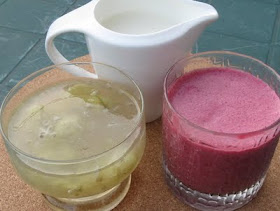Having said that, I don't usually use pumpkin in my baking, after trying and hating pumpkin pie a few years ago. When my children were younger we didn't get caught up with the growing celebration of Hallowe'en, either, regarding it as a 'foreign' import which might go away if we ignored it. So I was somewhat surprised to find a tin of pumpkin purée in my store cupboard, although the half-price 'reduced to clear' label may have had something to do with why I bought it. Anyone who knows me knows that I can't resist a food bargain!
I'm not the only person to have tried Martha Stewart's recipe for Pumpkin-Swirl Brownies recently; I've seen it on several (or maybe even many) other blogs in the last few days, starting with this one on 'Cake or Death?'. That isn't a reason in itself to try the recipe - my reasoning was that combining the pumpkin with chocolate was possibly the only way I'd be able to sneak it past other members of the family! I found recipes which mixed pumpkin purée into chocolate cake batter, but disguising it that completely seemed to defeat the object of using pumpkin in the first place. The effect created by layering a pumpkin flavoured batter with a chocolate batter and swirling them together seemed ideal; a fabulous visual effect, and possibly a better chance of discerning the separate flavours.
The recipe was straightforward to follow, although I did convert the American cup volumes and ounce weights into metric weights and measures - for some reason I just don't feel confident using cups after years of relying on scales. Despite warnings about working quickly because the batters, particularly the chocolate one, 'set' quickly, I didn't find this to be a problem. The alternate layers of batter were quite thin and I found it difficult to spread them on top of each other without disturbing the layer beneath, but it wasn't a major problem - it just upset my desire for perfection not to be able to spread the second and subsequent layers to the edges of the tin - but I soon realised this could help rather than hinder the final visual effect.
Here's the 'translation' of the recipe to metric weights, rounded to the nearest 5g, to suit my scales:
115g butter
170g plain chocolate (72% cocoa solids)
240g plain flour
1 teaspoon baking powder
1/4 teaspoon cayenne powder
400g caster sugar
4 large eggs
1 tablespoon vanilla extract
275g tinned pumpkin purée
80mls sunflower oil
1 teaspoon ground cinnamon
1/4 teaspoon freshly grated nutmeg
75g chopped nuts (I used pecans)
Follow the recipe as in the link - you may find these tips useful:
Mix the oil into the pumkin in a small bowl, and add the cinnamon and nutmeg. You're less likely to forget anything if it's all in one bowl, ready to go.
When it came to dividing the base batter in half I used my scales and found that half the batter was 400g. Next time I can just take out 400g into a second bowl, making one less bowl to wash up.
I found judging the point that the cake was cooked quite a problem. although it felt firm it still didn't test as done when it had been in the oven for 50 minutes, and I was mindful that as a brownie it shouldn't be overcooked. I decided to ignore my testing probe and take the cake out of the oven.
When cooled and cut, my judgement was that the pumpkin part was slightly undercooked and the chocolate maybe slightly overcooked for a brownie. There were as many adverse comments as good ones, about this bake, on the website and perhaps that's the fundamental problem with the cake - the two layers won't cook in the same time. If you cook until the pumpkin layers are done then it is no longer the texture of a brownie, as the chocolate layers will be well overcooked.
The undercooked pumkin didn't detract from the final result, as it kept the texture chewy and moist - as you would want a brownie. Overall the flavour and texture was very well balanced - the pumpkin was noticeable, but not dominant; the spicing was very subtle with the cayenne only just detectable as an added warmth, gentle but not intrusive and the texture was right for a brownie.

If I ever come across cheap tins of pumpkin again, this would be on the list to make again, although in my quest for a recipe I found several that I would like to try, including this lovely looking bundt cake from Hilary at 'Let Her Bake Cake'.










